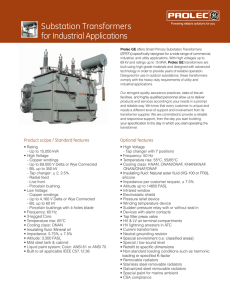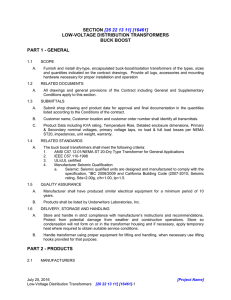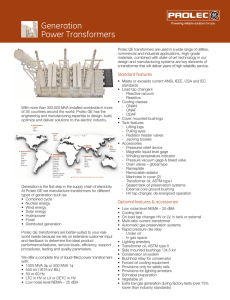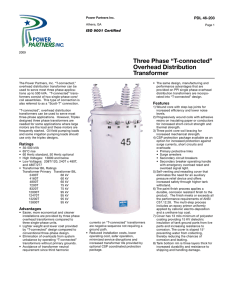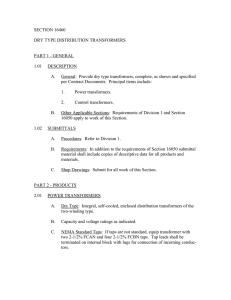Original Revision Request
advertisement
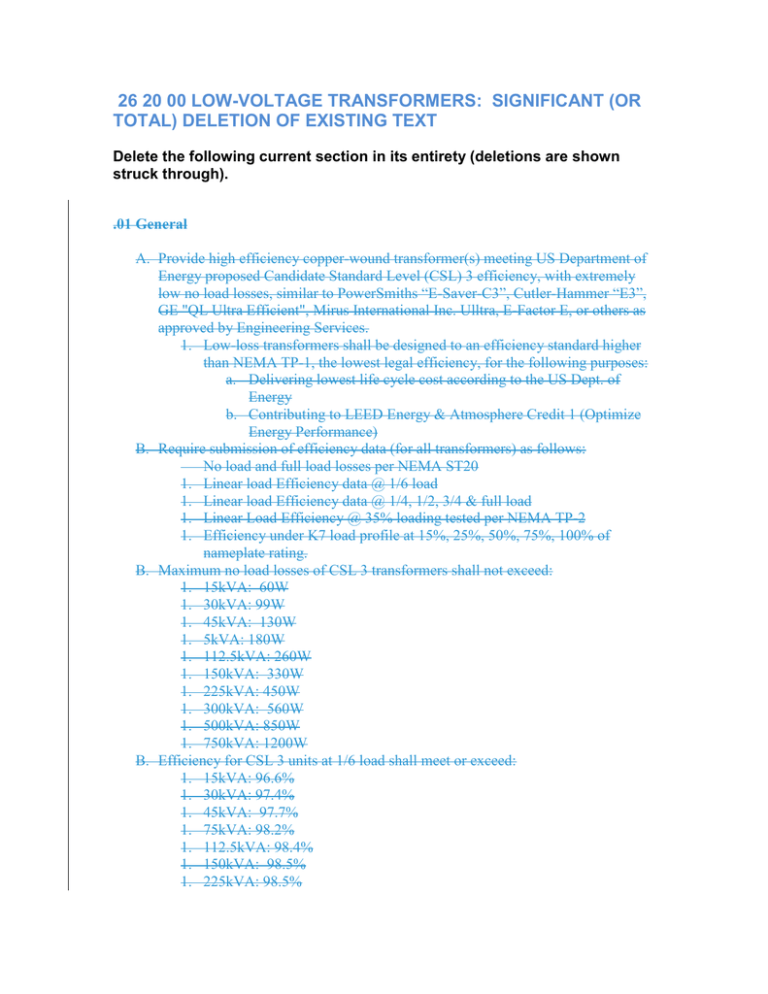
26 20 00 LOW-VOLTAGE TRANSFORMERS: SIGNIFICANT (OR
TOTAL) DELETION OF EXISTING TEXT
Delete the following current section in its entirety (deletions are shown
struck through).
.01 General
A. Provide high efficiency copper-wound transformer(s) meeting US Department of
Energy proposed Candidate Standard Level (CSL) 3 efficiency, with extremely
low no load losses, similar to PowerSmiths “E-Saver-C3”, Cutler-Hammer “E3”,
GE "QL Ultra Efficient", Mirus International Inc. Ulltra, E-Factor E, or others as
approved by Engineering Services.
1. Low-loss transformers shall be designed to an efficiency standard higher
than NEMA TP-1, the lowest legal efficiency, for the following purposes:
a. Delivering lowest life cycle cost according to the US Dept. of
Energy
b. Contributing to LEED Energy & Atmosphere Credit 1 (Optimize
Energy Performance)
B. Require submission of efficiency data (for all transformers) as follows:
No load and full load losses per NEMA ST20
1. Linear load Efficiency data @ 1/6 load
1. Linear load Efficiency data @ 1/4, 1/2, 3/4 & full load
1. Linear Load Efficiency @ 35% loading tested per NEMA TP-2
1. Efficiency under K7 load profile at 15%, 25%, 50%, 75%, 100% of
nameplate rating.
B. Maximum no load losses of CSL 3 transformers shall not exceed:
1. 15kVA: 60W
1. 30kVA: 99W
1. 45kVA: 130W
1. 5kVA: 180W
1. 112.5kVA: 260W
1. 150kVA: 330W
1. 225kVA: 450W
1. 300kVA: 560W
1. 500kVA: 850W
1. 750kVA: 1200W
B. Efficiency for CSL 3 units at 1/6 load shall meet or exceed:
1. 15kVA: 96.6%
1. 30kVA: 97.4%
1. 45kVA: 97.7%
1. 75kVA: 98.2%
1. 112.5kVA: 98.4%
1. 150kVA: 98.5%
1. 225kVA: 98.5%
1. 300kVA: 98.6%
2. 500kVA: 98.7%
2. 750kVA: 98.7%
B. Efficiency for CSL 3 units under K-7 nonlinear load at 50% of nameplate rating:
2. 15kVA: 97.2%
2. 30kVA: 97.7%
2. 45kVA: 97.9%
2. 75kVA: 98.1%
2. 112.5kVA: 98.5%
2. 150kVA: 98.7%
2. 225kVA: 98.8%
2. 300kVA: 98.8%
2. 500kVA: 98.9%
2. 750kVA: 99.1%
Replace with following text.
.01 General
A. Low-loss transformers shall be designed to latest DOE standard efficiency
requirements or higher for the following purposes:
1. Delivering lowest life cycle cost according to the US Dept. of Energy
2. Contributing to LEED Energy & Atmosphere Credit 1 (Optimize Energy
Performance)
.02 Guide Specifications
A. Design Professional shall carefully review and edit the guideline specifications
below, adapting them as needed to achieve application-specific, fully developed
specifications for each project.
B. These shall be edited using the process described in the instructions contained at
the beginning of the document. Proposed modifications shall be reviewed with
OPP Engineering Services.
C. Finalized version shall be included in the project contract documents. Use of other
specifications is not acceptable.
Document
Version
Date
Low-Voltage Transformer
Guide Specification.docx
June
2016
University’s guide specification for LowVoltage Transformer; to be used by the
design professional.
June
2016
Typical University Transformer Datasheet
for the
Professionals use. The datasheet
instructions are found in the transformer
guide specification and a sample is found in
Division 26 00 00.
Transformer
Datasheet.doc
Description
END of revision
Update Commentary:
Section was updated primarily for the following reasons:
1) Deleted old section and replaced with new section, which includes a new
guide specification section and new additional datasheet.
June 2016
PENN STATE UNIVERSITY
REV – 1.0
Copyright 2015 by The American Institute of Architects (AIA)
Exclusively published and distributed by Architectural Computer Services, Inc. (ARCOM) for the AIA
SECTION 262200 - LOW-VOLTAGE TRANSFORMERS
TIPS:
To view non-printing Editor's Notes that provide guidance for editing, click on Masterworks/Single-File
Formatting/Toggle/Editor's Notes.
To read detailed research, technical information about products and materials, and coordination
checklists, click on Masterworks/Supporting Information.
Revise this Section by deleting and inserting text to meet Project-specific requirements.
Verify that Section titles referenced in this Section are correct for this Project's Specifications; Section
titles may have changed.
General Notes:
1. This guide specification is intended to provide the Design Professional with a basic guideline of
minimum OPP requirements.
2. The guide specification shall be carefully reviewed and edited with respect to application-specific
project requirements. Proposed modifications shall be reviewed with OPP Staff.
3. Finalized version shall be included in the project contract documents.
Editing Notes
1. This OPP Guide specification must only be altered by notation (i.e. deleted text with
strikethrough and additional text with double underline). This shall be accomplished by using
Tools /Track Changes / Highlight Changes, and select "Track changes while editing" in MS Word
or equivalent.
2. The Review Submittal Specification section shall be provided in electronic form for OPP Review.
3. Leave the following Note ("For Construction Document Review, Design Submittal") as part of the
Review Submittal, to aid any Reviewer to understand WHY there are strikeouts and underlines.
Also, leave any “DESIGNER NOTE” placed in this Guide Spec.
4. AFTER comments are received from PSU and incorporated, the strikeouts and underlines shall
be removed, and the REVIEWER NOTEs deleted, before the spec is issued for Bidding.
5. Data Sheet Instructions:
a. Engineer completes “SPEC DATA” column with information about equipment including
but not limited to ratings, features and options. The data sheet is then submitted with
completed specifications for bid.
LOW-VOLTAGE TRANSFORMERS
262200-1
June 2016
PENN STATE UNIVERSITY
REV – 1.0
b. Manufacturer completes “VENDOR DATA” column and returns completed data sheet
with bid or submittal.
c. Engineer verifies that design specifications have been met by checking that specified
features match submitted features.
PART 1 - GENERAL
1.1
RELATED DOCUMENTS
Retain or delete this article in all Sections of Project Manual.
A.
Drawings and general provisions of the Contract, including General and Supplementary
Conditions and Division 01 Specification Sections, apply to this Section.
B.
All sections of the project manual are directly applicable to this specification section. Should a
conflict arise between specification sections or between specifications and drawings and/or code
requirements, the contractor shall notify the Architect/Engineer of the conflict in writing. If
direction is not provided prior to the submission of the bid, the contractor shall price the more
extensive system.
1.2
SUMMARY
A.
1.3
Section Includes: Distribution, dry-type transformers rated 600 V and less, with capacities up
to 1000 kVA.
ACTION SUBMITTALS
A.
Product Data: For each type of product.
1.
2.
B.
Include construction details, material descriptions, dimensions of individual components
and profiles, and finishes for each type and size of transformer.
Include rated nameplate data, capacities, weights, dimensions, minimum clearances,
installed devices and features, and performance for each type and size of transformer.
a.
Performance Data requirements:
1)
No load and full load losses per NEMA ST20
2)
Linear load Efficiency data @ 1/6, 1/4, 1/2, 3/4 & full load
Shop Drawings:
1.
2.
3.
Detail equipment assemblies and indicate dimensions, weights, loads, required
clearances, method of field assembly, components, and location and size of each field
connection.
Vibration Isolation Base Details: Detail fabrication including anchorages and attachments
to structure and to supported equipment.
Include diagrams for power, signal, and control wiring.
LOW-VOLTAGE TRANSFORMERS
262200-2
June 2016
1.4
PENN STATE UNIVERSITY
REV – 1.0
INFORMATIONAL SUBMITTALS
Retain "Seismic Qualification Certificates" Paragraph below if required by seismic criteria applicable to
Project. Coordinate with Section 260548.16 "Seismic Controls for Electrical Systems." See IBC 2012 &
ASCE/SEI 7 for certification requirements for equipment and components.
A.
Seismic Qualification Certificates: For transformers, accessories, and components, from
manufacturer.
1.
2.
3.
Basis for Certification: Indicate whether withstand certification is based on actual test of
assembled components or on calculation.
Dimensioned Outline Drawings of Equipment Unit: Identify center of gravity and locate
and describe mounting and anchorage provisions.
Detailed description of equipment anchorage devices on which the certification is based
and their installation requirements.
Coordinate "Qualification Data" Paragraph below with qualification requirements in Section 014000
"Quality Requirements" and as may be supplemented in "Quality Assurance" Article.
B.
Qualification Data: For testing agency.
C.
Source quality-control reports.
Retain "Field quality-control reports" Paragraph below if Contractor is responsible for field qualitycontrol testing and inspecting.
D.
Field quality-control reports.
E.
Verification of meeting efficiency standard criteria.
F.
Manufacturer’s recommended clearances around transformer.
1.5
CLOSEOUT SUBMITTALS
A.
1.6
Operation and Maintenance Data: For transformers to include in emergency, operation, and
maintenance manuals.
QUALITY ASSURANCE
Retain "Testing Agency Qualifications" Paragraph below if Contractor {or manufacturer} selects testing
agency or if Contractor is required to provide services of a qualified testing agency in "Field Quality
Control" Article. Qualification requirements are in addition to those specified in Section 014000 "Quality
Requirements." Delete this paragraph when Owner engages an independent testing agency or when
requiring the manufacturer or manufacturer's authorized field representative to perform on-site testing.
A.
Testing Agency Qualifications: Accredited by NETA.
1.
Testing Agency's Field Supervisor: Certified by NETA to supervise on-site testing.
LOW-VOLTAGE TRANSFORMERS
262200-3
June 2016
1.7
PENN STATE UNIVERSITY
REV – 1.0
DELIVERY, STORAGE, AND HANDLING
A.
Temporary Heating: Apply temporary heat according to manufacturer's written instructions
within the enclosure of each ventilated-type unit, throughout periods during which equipment is
not energized and when transformer is not in a space that is continuously under normal control
of temperature and humidity.
PART 2 - PRODUCTS
Manufacturers and products listed in SpecAgent and Masterworks Paragraph Builder are neither
recommended nor endorsed by the AIA or ARCOM. Before inserting names, verify that manufacturers
and products listed there comply with requirements retained or revised in descriptions and are both
available and suitable for the intended applications. For definitions of terms and requirements for
Contractor's product selection, see Section 016000 "Product Requirements."
2.1
MANUFACTURERS
A.
Manufacturers: Subject to compliance with requirements, available manufacturers offering
products that may be incorporated into the Work include, but are not limited to the following:
1.
2.
3.
4.
5.
6.
B.
2.2
Eaton.
General Electric Company.
Powersmiths International Corp.
Siemens Power Transmission & Distribution, Inc.
Square D; by Schneider Electric.
Hammond Power Solutions.
Source Limitations: Obtain each transformer type from single source from single manufacturer.
GENERAL TRANSFORMER REQUIREMENTS
A.
Description: Factory-assembled and -tested, air-cooled units for 60-Hz service.
B.
Electrical Components, Devices, and Accessories: Listed and labeled as defined in NFPA 70, by
a qualified testing agency, and marked for intended location and application.
C.
Cores: Electrical grade, non-aging silicon steel with high permeability and low hysteresis losses.
D.
Coils: Continuous windings without splices except for taps.
1.
Internal Coil Connections: Brazed or pressure type.
Usually retain copper option in "Coil Material" Subparagraph below. Aluminum can be acceptable.
2.
Coil Material: Copper.
E.
Encapsulation: Transformers smaller than 15 kVA shall have core and coils completely resin
encapsulated.
LOW-VOLTAGE TRANSFORMERS
262200-4
June 2016
PENN STATE UNIVERSITY
REV – 1.0
F.
Shipping Restraints: Paint or otherwise color code bolts, wedges, blocks, and other restraints
that are to be removed after installation and before energizing. Use fluorescent colors that are
easily identifiable inside the transformer enclosure.
G.
Transformers shall meet DOE 10 CFR Part 431 for energy efficiency requirements.
2.3
DISTRIBUTION TRANSFORMERS
A.
Comply with NFPA 70 and list and label as complying with UL 1561.
Retain first paragraph below if seismic bracing is required. Coordinate with Parts 1 and 3.
B.
Provide transformers that are constructed to withstand seismic forces specified in
Section 260548.16 "Seismic Controls for Electrical Systems."
C.
Cores: One leg per phase.
Typical PSU transformer is indoors. If several types of enclosures are required for Project, delete
paragraphs and indicate enclosure type on Drawings.
D.
Enclosure: Ventilated[Totally enclosed, nonventilated].
1.
2.
NEMA 250, [Type 3R]: Core and coil shall be encapsulated within resin compound
[utilizing a vacuum pressure impregnation process] to seal out moisture and air.
KVA Ratings: Based on convection cooling only and not relying on auxiliary fans.
Retain "Transformer Enclosure Finish" Paragraph below for custom finish.
E.
Transformer Enclosure Finish: Comply with NEMA 250.
1.
Finish Color: NSF/ANSI 61 gray.
In first three paragraphs below, first option for each size is most prevalent standard with many
manufacturers; second option is available from most manufacturers. If multiple transformers are required
with different tap arrangements, delete paragraphs and indicate tap information on Drawings.
F.
Taps for Transformers: Two 2.5 percent taps FCAN and four 2.5 percent taps FCBN.
See "Insulation Ratings" Article in Evaluations for discussion of insulation classes. See "Energy
Considerations" Article in the Evaluations for discussion of relative efficiencies. Temperature rise of 115
or 80 deg C only applies to transformers 15 kVA and larger.
G.
Insulation Class, Smaller than 15 kVA: 185 deg C, UL-component-recognized insulation
system with a maximum of 115-deg C rise above 40-deg C ambient temperature.
H.
Insulation Class, 15 kVA and Larger: 220 deg C, UL-component-recognized insulation system
with a maximum of 115-deg C rise above 40-deg C ambient temperature.
Retain features in six paragraphs below to suit Project. Coordinate with Drawings.
LOW-VOLTAGE TRANSFORMERS
262200-5
June 2016
PENN STATE UNIVERSITY
REV – 1.0
Discuss with PSU if K-rated transformers are needed for specific applications, Designer shall provide
justification for using K-rated transformers.
Double-size neutral is usually standard for K-factor rated, harmonic canceling, and motor drive isolation
transformers and should be retained. It is optional for other transformers but is only needed if there are
large harmonic currents in the secondary loads. Harmonic-canceling and drive-isolation transformers are
not specified in this Section but can be added by delineating additional requirements. See Evaluations for
discussion of harmonics.
Indicate wall-mounted transformers on Drawings. Generally, factory-made wall-mounted brackets are
available for transformers up to 75 kVA. High-efficiency, shielding, and K-factor construction increase
transformer weight. Verify that wall brackets are available from specified manufacturers for specified
sizes. Verify compliance with seismic requirements.
NEMA ST 20 has been rescinded, but its sound-level requirements are still recognized as benchmarks for
maximum sound levels. Sound levels less than NEMA ST 20 are not standard and may increase cost and
delivery time or may simply result in a larger size transformer with KVA derated. Low-sound-level
options are 3dB, 5dB, and 8dB below those in NEMA ST 20. NEMA ST 20 sound levels are as follows:
Up to 9 kVA: 40 dBA; 30 to 50 kVA: 45 dBA; 51 to 150 kVA: 50 dBA; 151 to 300 kVA: 55 dBA; 301 to
500 kVA: 60 dBA; 501 to 700 kVA: 62 dBA; 701 to 1000 kVA: 64 dBA; 1001 to 1500 kVA: 65 dBA.
See Evaluations for discussion of sound generated by transformers.
I.
2.4
Low-Sound-Level Requirements: Maximum sound levels when factory tested according to
NEMA ST20.
IDENTIFICATION DEVICES
Retain this article to specify nameplates. Coordinate names of transformers with Drawings and schedules.
A.
2.5
Nameplates: Engraved, metal nameplate for each transformer, mounted with corrosion-resistant
screws.
SOURCE QUALITY CONTROL
A.
Test and inspect transformers according to IEEE C57.12.01 and IEEE C57.12.91.
1.
2.
3.
4.
5.
6.
7.
8.
Resistance measurements of all windings at the rated voltage connections and at all tap
connections.
Ratio tests at the rated voltage connections and at all tap connections.
Phase relation and polarity tests at the rated voltage connections.
No load losses, and excitation current and rated voltage at the rated voltage connections.
Impedance and load losses at rated current and rated frequency at the rated voltage
connections.
Applied and induced tensile tests.
Regulation and efficiency at rated load and voltage.
Insulation Resistance Tests:
a.
b.
High-voltage to ground.
Low-voltage to ground.
LOW-VOLTAGE TRANSFORMERS
262200-6
June 2016
PENN STATE UNIVERSITY
c.
9.
REV – 1.0
High-voltage to low-voltage.
Temperature tests.
Retain "Factory Sound-Level Tests" Paragraph below if retaining "Low-Sound-Level Requirements"
Paragraph in "Distribution Transformers" Article. Sound-level tests for project equipment may cost over
$500 per unit.
B.
Factory Sound-Level Tests: [Conduct prototype sound-level tests on production-line
products].
PART 3 - EXECUTION
3.1
EXAMINATION
A.
Examine conditions for compliance with enclosure- and ambient-temperature requirements for
each transformer.
B.
Verify that field measurements are as needed to maintain working clearances required by
NFPA 70 and manufacturer's written instructions.
C.
Examine walls, floors, roofs, and concrete bases for suitable mounting conditions where
transformers will be installed.
Revise 5-ohm value in first paragraph below to suit Project.
D.
Verify that ground connections are in place and requirements in Section 260526 "Grounding
and Bonding for Electrical Systems" have been met. Maximum ground resistance meet
requirements in 260526.
E.
Environment: Enclosures shall be rated for the environment in which they are located. Covers
for NEMA 250, Type 4X enclosures shall not cause accessibility problems.
F.
Proceed with installation only after unsatisfactory conditions have been corrected.
3.2
INSTALLATION
Verify seismic-bracing requirements with authorities having jurisdiction. Wall-mounted transformers may
not be appropriate in areas of seismic activity. Discuss with PSU suspension of transformers.
If appropriate, retain first paragraph below for projects in areas of seismic activity.
A.
Install transformers level and plumb on a concrete base with vibration-dampening supports.
B.
Construct concrete bases according to [Section 033000 "Cast-in-Place Concrete"] [or]
[Section 033053 "Miscellaneous Cast-in-Place Concrete"] and anchor floor-mounted
transformers according to manufacturer's written instructions [, seismic codes applicable to
Project,] and requirements in Section 260529 "Hangers and Supports for Electrical Systems."
LOW-VOLTAGE TRANSFORMERS
262200-7
June 2016
PENN STATE UNIVERSITY
REV – 1.0
1.
Coordinate transformer install with housekeeping pad or floor mounted install per
location and design documents.
2.
Coordinate size and location of concrete bases with actual transformer provided. Cast
anchor-bolt inserts into bases. Concrete, reinforcement, and formwork requirements are
specified with concrete.
C.
Secure transformer to concrete base according to manufacturer's written instructions.
D.
Secure covers to enclosure and tighten all bolts to manufacturer-recommended torques to reduce
noise generation.
E.
Remove shipping bolts, blocking, and wedges.
3.3
CONNECTIONS
A.
Ground equipment according to Section 260526 "Grounding and Bonding for Electrical
Systems."
B.
Connect wiring according to Section 260519 "Low-Voltage Electrical Power Conductors and
Cables."
C.
Tighten electrical connectors and terminals according to manufacturer's published torquetightening values. If manufacturer's torque values are not indicated, use those specified in
UL 486A-486B.
D.
Provide flexible connections at all conduit and conductor terminations and supports to eliminate
sound and vibration transmission to the building structure.
3.4
FIELD QUALITY CONTROL
Retain one of first four paragraphs below. Retain "Testing Agency" Paragraph below if Owner will hire
an independent testing agency.
Retain "Testing Agency" Paragraph below to require Contractor to hire an independent testing agency.
A.
Testing Agency: Engage a qualified testing agency to perform tests and inspections.
Retain "Manufacturer's Field Service" Paragraph below to require a factory-authorized service
representative to perform tests and inspections.
B.
Manufacturer's Field Service: Engage a factory-authorized service representative to test and
inspect components, assemblies, and equipment installations, including connections.
Retain "Perform tests and inspections" Paragraph below to require Contractor to perform tests and
inspections and retain the optional text to require Contractor to arrange for the assistance of a factory
authorized service agent.
C.
Perform tests and inspections [with the assistance of a factory-authorized service
representative].
LOW-VOLTAGE TRANSFORMERS
262200-8
June 2016
PENN STATE UNIVERSITY
REV – 1.0
Tests referenced in subparagraph below are from NETA ATS and include inspection procedures to verify
proper installation. They also include tests and measurements of insulation resistance and turns ratios.
Cost of extensive testing may not be warranted for some projects. Revise subparagraph to suit Project.
D.
Tests and Inspections:
1.
Perform each visual and mechanical inspection and electrical test stated in NETA ATS
for dry-type, air-cooled, low-voltage transformers. Certify compliance with test
parameters. Including all optional tests unless waived by Owner.
E.
Remove and replace units that do not pass tests or inspections and retest as specified above.
F.
Infrared Scanning: After Substantial Completion and building occupancy, perform an infrared
scan of transformer connections.
1.
2.
3.
G.
3.5
Use an infrared-scanning device designed to measure temperature or detect significant
deviations from normal values. Provide documentation of device calibration.
Perform two follow-up infrared scans of transformers, one at four months and the other at
11 months after Substantial Completion.
Prepare a certified report identifying transformer checked and describing results of
scanning. Include notation of deficiencies detected, remedial action taken, and scanning
observations after remedial action.
Test Labeling: On completion of satisfactory testing of each unit, attach a dated and signed
"Satisfactory Test" label to tested component.
ADJUSTING
A.
Record transformer secondary voltage at each unit for at least 48 hours of typical occupancy
period no more than four months after substantial completion and building occupancy. Adjust
transformer taps to provide optimum voltage conditions at secondary terminals. Optimum is
defined as not exceeding nameplate voltage plus 5 percent and not being lower than nameplate
voltage minus 3 percent at maximum load conditions. Submit recording and tap settings as test
results.
B.
Output Settings Report: Prepare a written report recording output voltage and tap settings.
3.6
CLEANING
A.
Vacuum dirt and debris; do not use compressed air to assist in cleaning.
END OF SECTION 262200
LOW-VOLTAGE TRANSFORMERS
262200-9

